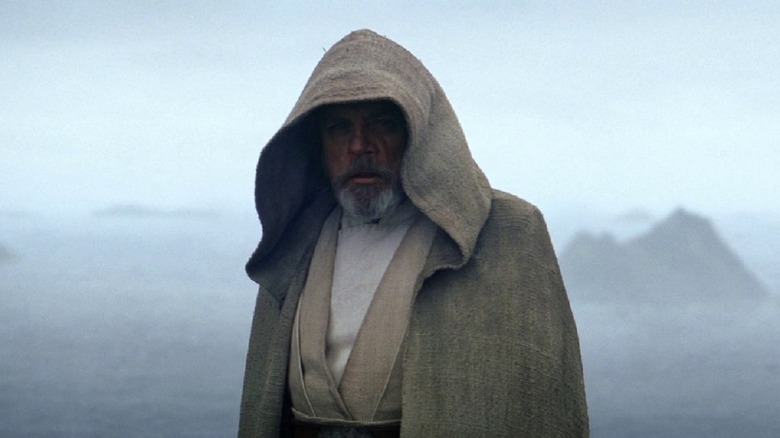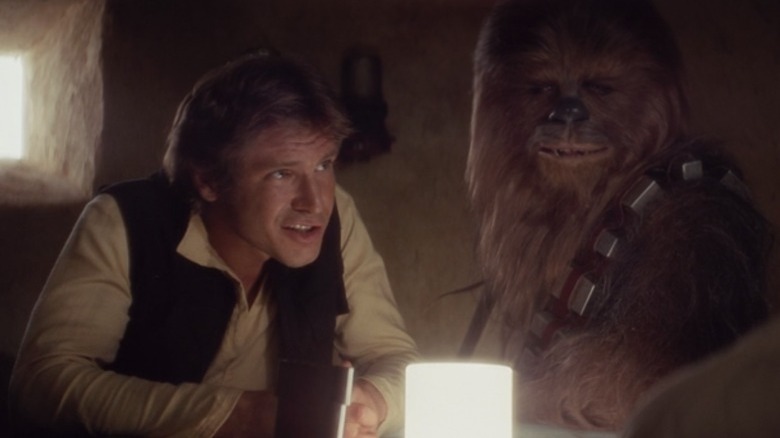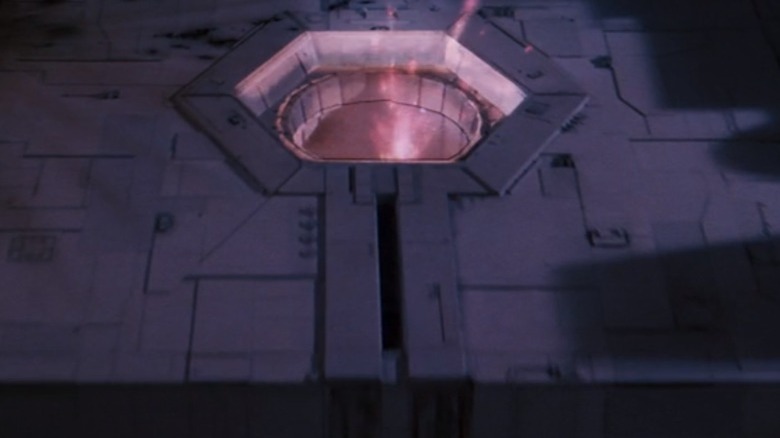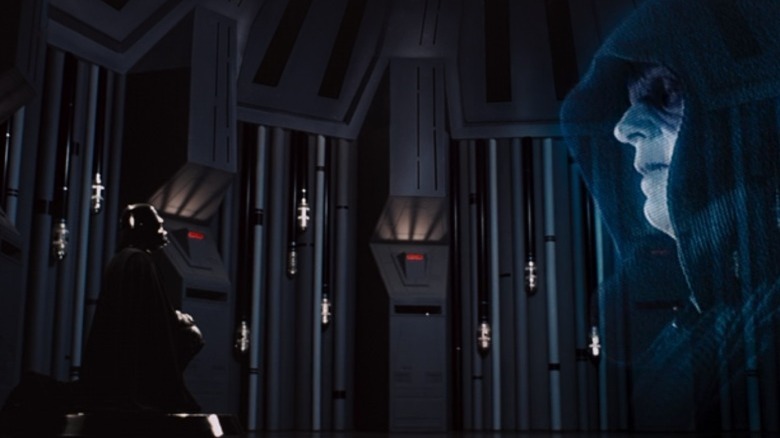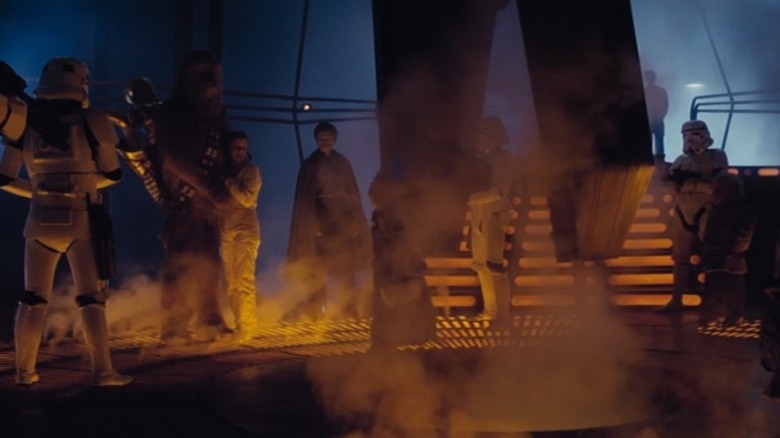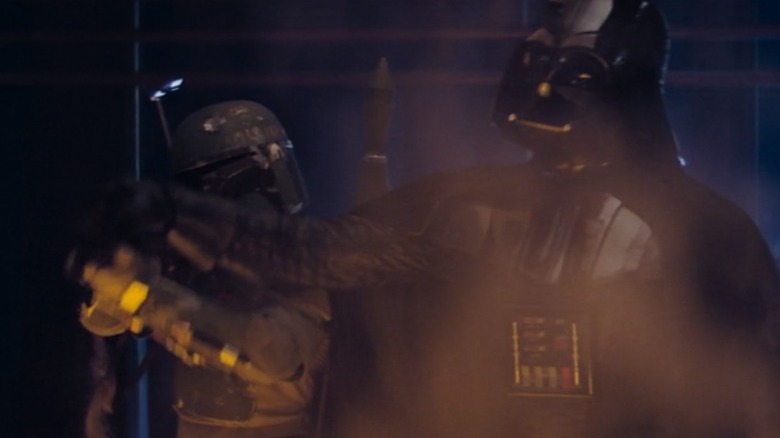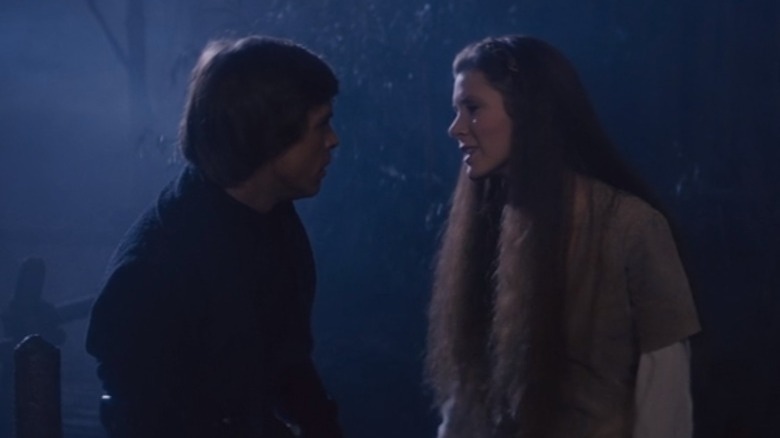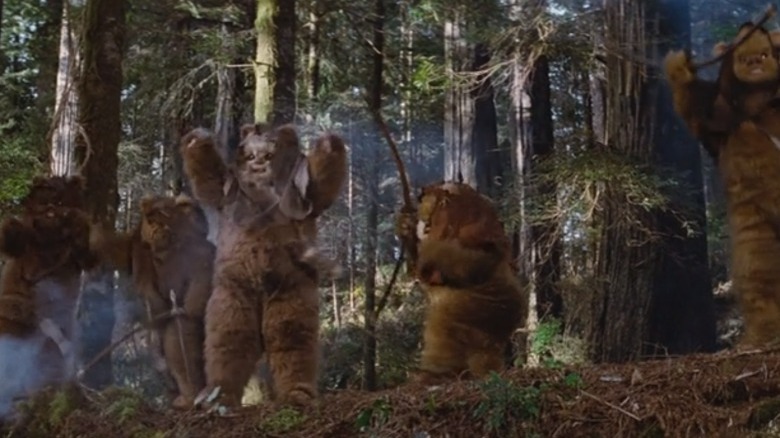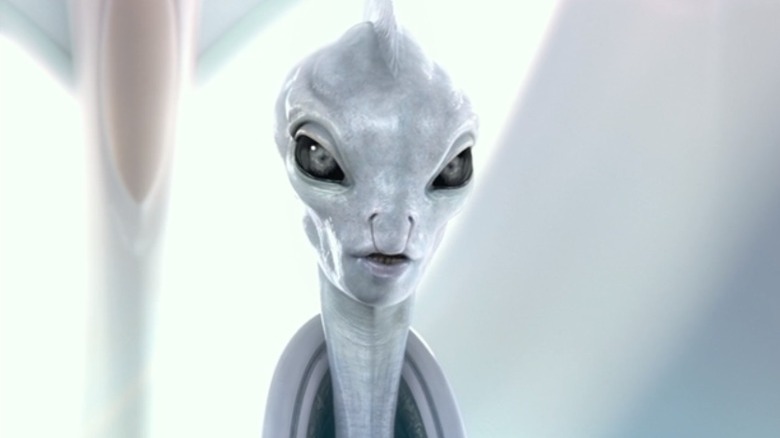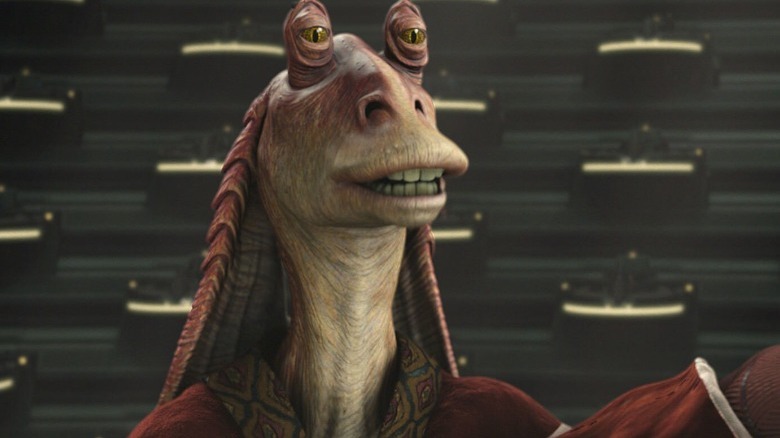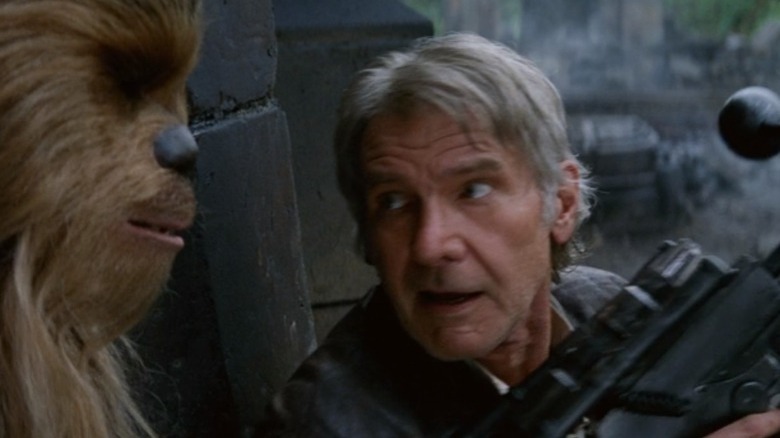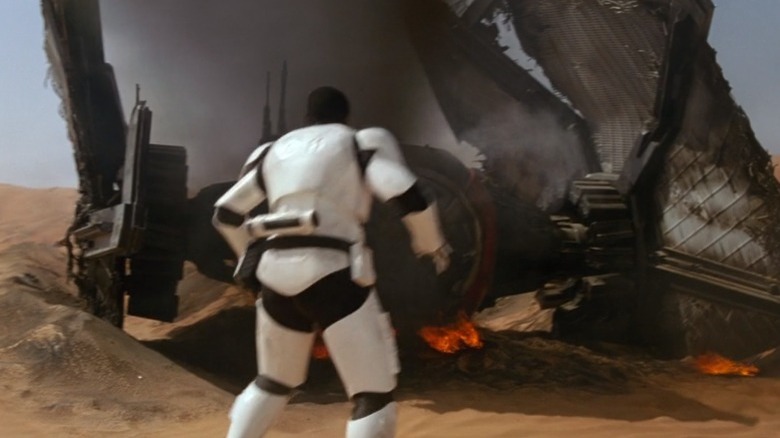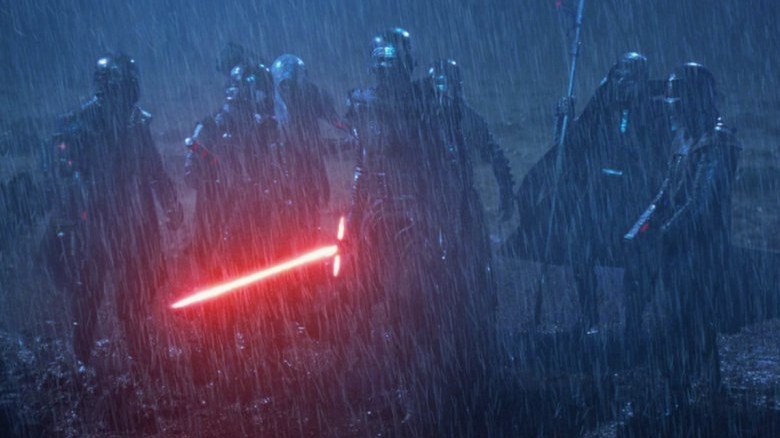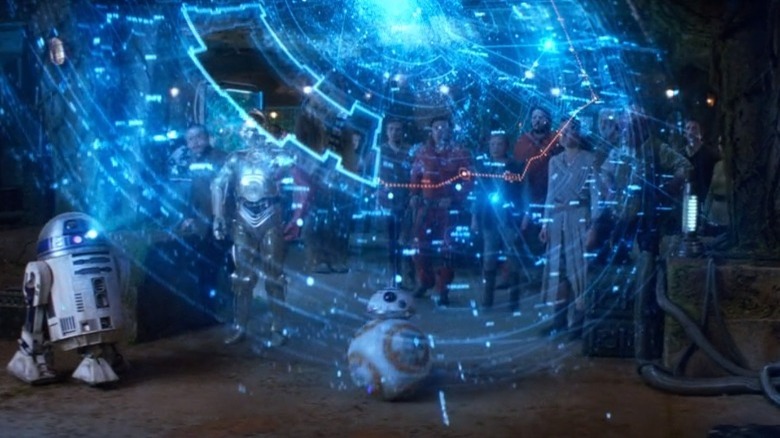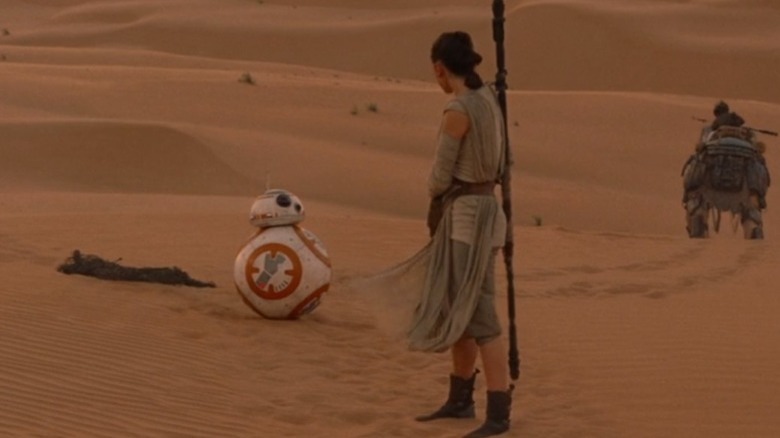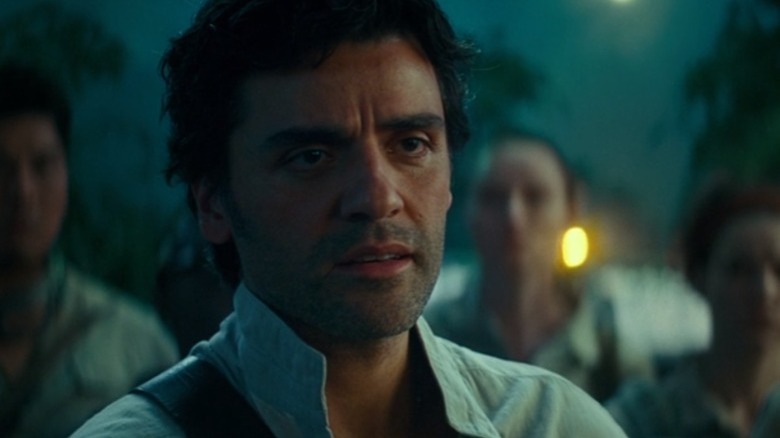15 Star Wars Plot Holes That Had To Be Explained Outside The Movies
"Star Wars" first entered popular culture back in 1977, and it took almost no time at all for the movie to become a cultural phenomenon. The first film had only one minor plot hole, but outside of Han Solo's (Harrison Ford) misunderstanding of interstellar distances and time, the film was, in a word, perfect. Then, a few years later, "The Empire Strikes Back" hit theaters, followed by "Return of the Jedi" a few years later.
With each entry into the Skywalker Saga, a new film came along and upended those that came before. New plot holes formed from movies released decades earlier, leaving fans wondering how such a thing could happen. Plot holes aren't uncommon in long-running franchises, but "Star Wars" seems to have mastered making them. Fortunately, for every movie in the Skywalker Saga, there are hundreds of comic books, novels, video games, and more to help fill in the gaps.
If you go through all nine films, you'll find plenty of plot holes throughout, many of which have been filled outside those films, and two outside flicks go a long way in filling as many holes as possible. Of the many, many plot holes in the Skywalker Saga, the most glaring ones have been filled in other properties within the franchise. These 16 plot holes sprouted up from Episodes I-IX, and they all got filled a long time ago in a galaxy far, far away.
Parsecs are a measurement of distance, not time! - A New Hope
It's one of the oldest gripes in the franchise: Han Solo's claim that the Millennium Falcon "made the Kessel run in less than 12 parsecs" as an indication of speed makes no sense. A parsec is 3.26 light years, so 12 of them would be 39.12 light years distance. It doesn't make any sense to be able to speed through the Kessel Run in a measure of distance, not time. At least, that was the chief complaint from Han's boast in "A New Hope."
It took some time, but the franchise finally filled the plot hole via "Solo: A Star Wars Story." The film's third act is pretty much the answer to the question, how could Han Solo do the Kessel Run in 12 parsecs? The answer is relatively simple: the Kessel Run is a route through chaotic and dangerous space that's 18 parsecs long, requiring careful navigation through a cluster of black holes called the Maw. Han's boast wasn't specifically about time; it was about distance. Specifically, he managed to complete the Kessel Run in a shorter distance than others dared try.
Of course, there's a reason nobody attempts the 12-parsec route – it's riddled with giant space-dwelling creatures called Summa-Verminoth. The massive beasts live within the Akkadese Maelstrom, which is what Han used as a shortcut. It all worked out, and fans had their answer when the movie was over.
How the Death Star was designed with a kill-switch of sorts - A New Hope
The final act of "A New Hope" sees Luke Skywalker (Mark Hamill) pilot an X-Wing fighter along a trench in the Death Star. He uses the Force to fire into an exhaust port, resulting in a chain reaction that destroys the space station. It's not an easy shot, and several more seasoned pilots died attempting to do what Luke did. Still, the fact that the Death Star had such a glaring and deadly engineering kill switch left many fans wondering why it was designed that way.
Fans pondered this for years, and sure, the compromised plans were a great way of introducing the weakness to the Rebellion, but why was it there in the first place? The answer finally came in "Rogue One: A Star Wars Story," which fills several plot holes, including the Death Star's weakness. It was purposefully designed by Galen Erso, the weapon's principal architect. Erso was forced to design the Death Star and its primary weapon, but he did what he could to create a flaw.
"Rogue One" is all about the mission to steal the Death Star plans from the Empire and exploit them. The film ends moments before "A New Hope" begins, so it does an excellent job of filling the plot hole. Additionally, while Rogue Two was there, Rogue One wasn't present at the Battle of Yavin, and now we know why: they were busy stealing the Death Star plans, and everyone died accomplishing the mission.
How Darth Vader learned who blew up the Death Star - The Empire Strikes Back
In "The Empire Strikes Back," Darth Vader (David Prowse) speaks to his master, who tells him, "The young Rebel who destroyed the Death Star. I have no doubt this boy is the offspring of Anakin Skywalker." At this point, nobody knows Vader is Luke's father, but beyond that, there lingers a question; how did they learn the identity of the Rebel pilot in the first place? It's a fair question because it's not as if the Rebel Alliance would broadcast Luke's identity to the Empire.
The 2015 "Darth Vader" series from Marvel Comics explains how he learned who blew up the Death Star and so much more. He tasks Boba Fett with finding the name for him, and the bounty hunter comes through. While speaking to Vader, he tells him only one word, and it's a biggie: "Skywalker." Evidently, Skywalker isn't a common name in the galaxy, so Vader learned two things at this moment: his child survived, and the Emperor lied to him about Padmé's death.
Granted, when the film was released in 1980, the details of Anakin and Padmé's relationship didn't exist. The comic focuses on what was known when it was published, so when Vader learns of his master's betrayal, he begins a plan to destroy him. That's why Vader tells Luke, "Luke. You can destroy the Emperor. He has foreseen this. It is your destiny. Join me. Together we can rule the galaxy as father and son."
Why Vader didn't recognize C-3PO on Cloud City - The Empire Strikes Back
In "The Empire Strikes Back," Han Solo is frozen in carbonite for transfer to Jabba the Hutt (also to ensure the process is survivable). Vader wants to use the same process on Luke, so Han's freezing is little more than a test. In the scene where he's about to be lowered into the chamber for, let's call it, preservation, all the major players are there, including C-3PO (Anthony Daniel).
Granted, he's a bit incomplete at this point and strapped to Chewbacca's back, but he's there. While there wasn't a plot hole from this encounter at the time, "The Phantom Menace" created a massive one. The film revealed that Anakin Skywalker, aka Darth Vader, was the one who originally created C-3PO. He had known the droid since childhood, and he gave him to Padmé as a gift at their wedding (she gave him R2-D2). C-3PO was involved in the Clone Wars, and Anakin spent plenty of time with him.
Fast-forward a bit, and Anakin falls to the dark side. For some reason, Vader forgot all about his childhood droid. As far as "Star Wars" canon is concerned, there's no explanation for his lack of recognition, but "Star Wars" Legends does have an answer. In "Star Wars Tales" #6, the story, "Thank the Maker," C-3PO's origins are revealed, and Vader does recognize him in Cloud City. He has a quiet moment with him and orders his parts sent to Chewie's cell, ultimately saving him.
Why Darth Vader stops Boba Fett killing Chewbacca - The Empire Strikes Back
Another plot hole that appeared during the Han Solo freezing scene involves Darth Vader and Chewbacca. When Han is about to go into the chamber, Chewie roars and assaults the Stormtroopers holding him back. This is an angry, rampaging Wookiee, so it's not a little thing, which is why Boba Fett (Jeremy Bulloch) raises his blaster and prepares to fire. Before he can fire off a shot, Darth Vader reaches over and pushes his weapon down, stopping him.
So, why did Vader save Chewbacca? There's no apparent reason for it, and it would have certainly been within his brand to slaughter Chewbacca, but he stopped it from happening. Fans had many theories about this, but it wasn't explained until Marvel Comics' "Star Wars: Darth Vader" #12, and it's probably not what fans thought. In the issue, Vader saw the close friendship between the Rebels as a weakness he could exploit, so killing Chewbacca would have limited this ability.
Vader thinks to himself during the scene, "Good ... Keep on believing it ... Believe that your friends have survived this long through strength or fortune ... instead of my design." This makes a lot of sense when, in "Return of the Jedi," Palpatine (Ian McDiarmid) uses Luke's friends as a weakness to try and enrage him and give in to the dark side of the Force — it's a Sith tactic to use relationships to one's advantage.
How Leia remembered her mother - Return of the Jedi
A touching moment between Luke and Leia (Carrie Fisher) in "Return of the Jedi" became a huge plot hole years later. In the scene, Luke asks Leia if she remembers her "real mother." She says that she remembers her a little bit and remembers that she was very beautiful, kind, and sad. It's a lovely moment, but the prequel trilogy revealed that her memories couldn't have happened.
Luke and Leia's mother died shortly after childbirth, so there's no way she could have any memories of her. That's a plot hole that needed some fixing, as it truly defies explanation when you take into account the events of "Revenge of the Sith." It took a couple of decades, but the answer was finally given in the novel, "The Princess and the Scoundrel."
In the novel, Leia recalls the memories she described to Luke, which reads, "But she did have a memory — of love, of closeness, of things she could not describe. It was impossible to put her feelings into words, but there was no denying their truth. It felt like ... a connection, a bond made of light." Essentially, Leia's connection to the Force is what made it possible for her to form memories of her mother, so her memories are more akin to the feelings she sensed when she was briefly with her.
How a group of cuddly forest bears defeated the Imperial forces on Endor - Return of the Jedi
There's something of a dividing line between fans of the original trilogy where Ewoks are concerned. Ewoks were clearly designed to appeal to children because they're adorable — at first glance. If you stop for a moment and consider who and what they are, Ewoks are far more vicious than they appear. Putting aside the fact that they likely ate the dead Stormtroopers after the final battle, these cuddly forest bears managed to defeat an Empire.
Ewoks are partisan fighters, and they should never be taken for granted. The Empire did that, and you know what happened to them. How exactly did a primitive band of adorable bearlike beings manage to defeat the Empire? Pretty much the same way any insurgency has done throughout history, and it's all explained in a story called "Apocalypse Endor" from the "Star Wars" Legends comic, "Star Wars Tales" #14.
In the comic, the Ewoks welcome the Empire with open arms when they arrive on Endor. Unfortunately, a misunderstanding leads to aggression, and things devolve from there. The Ewoks mount a moon-wide offensive against the Empire, so they are 100% prepared and ready when the Rebels arrive and fight to take over the shield generator. Years of preparations culminated in the final battle that saw the Ewoks absolutely dominate the Empire, and it all started when an Ewok offered a flower to a Trooper.
Why Jedi Master Sifo-Dyas ordered the clone army from the Kaminoans - Attack of the Clones
In "Attack of the Clones," Obi-Wan Kenobi's (Ewan McGregor) investigation leads him to the planet Kamino, where he finds a clone army nearing full development. When he meets with the Prime Minister, he's told that the army was ordered by Jedi Master Sifo-Dyas, which puzzles him because Sifo-Dyas died years earlier. Unfortunately, the conveniently ready army helped usher in an era of galactic civil war, and the explanation for who, how, and why the army was created was left out of the movie. Fortunately, it was later addressed in "Star Wars: The Clone Wars."
The episode, "The Lost One," reveals that Sifo-Dyas did, in fact, order the clone army via the manipulation of Count Dooku. Dooku later hired the Pike Syndicate to capture and execute Sifo-Dyas, ensuring the secrets of the clone army died with him. This revelation filled the plot hole that left many fans wondering more about who Sifo-Dyas was and why he raised the army. Essentially, he believed a great conflict was on the horizon, and an army was necessary.
In addition to learning about the clone army on Kamino, Obi-Wan discovers that the planet itself was erased from the Jedi Temple's database. Jedi Master Jocasta Nu tells him, "If an item does not appear in our records, it does not exist!" It's not made clear who erased the records until the "Tales of the Jedi" episode, "The Sith Lord," that it was Dooku who erased the data.
How and why did Jar Jar Binks become a senator - Attack of the Clones
Whether you love him or hate him, it's undeniable that Jar Jar Binks (Ahmed Best) played an essential role in galactic affairs. He was manipulated into several actions that resulted in the ouster of Supreme Chancellor Valorum (Terence Stamp), ushering in Sheev Palpatine to fill the position. In "Attack of the Clones," Jar Jar once more alters the government of the Galactic Republic by nominating emergency powers for the Supreme Chancellor, giving Palpatine the authority to create a Grand Army of the Republic (this was necessary for his plan to take over the galaxy).
One thing that's not made clear in the film is precisely how Jar Jar went from being an outcast in his own society to representing the same at the Galactic Republic. After all, Naboo already had a senator representing the planet — Senator Padmé Amidala (Natalie Portman) — so how did Jar Jar suddenly become elevated to a similar position? Thankfully, it's all made clear in "An Innocent Abroad," a detailed accounting of Jar Jar in "Star Wars Insider" from January 2018.
The article explains that between "The Phantom Menace" and "Attack of the Clones," Jar Jar became a Junior Representative under Senator Amidala, primarily representing the Gungans and also Naboo. He was her spokesperson when she wasn't on Coruscant. In "Aftermath: Empire's End," it's explained that after the Republic fell, Jar Jar was exiled once more to Theed, where he entertained children in the streets.
Why Han Solo was surprised firing Chewbacca's bowcaster - The Force Awakens
"The Force Awakens" brought back the fandom's favorite characters, including Han Solo and Chewbacca. The film is nostalgic and narratively reminiscent of "A New Hope," so their inclusion was a welcome addition. When they take Finn (John Boyega) and Rey (Daisy Ridley) to Maz Kanata's (Lupita Nyong'o) castle on Takodana, it doesn't take long before the First Order shows up to spoil everyone's good time. During the fight, Han expertly eliminates many Stormtroopers with his blaster but asks Chewie for his bowcaster, which he then fires.
It's clear from the look on his face and the way he turns to Chewie and says, "I like this thing," that he'd never fired the weapon before. That's a bit of a plot hole because, as we all learned in "Solo," they had been together for decades. Why wouldn't he have grabbed his pal's bowcaster at any moment in the past half-century? While an explanation for this hasn't been revealed in "Star Wars" canon, the Legends novels comprising "The Han Solo Adventures" explains it.
A Wookiee bowcaster isn't like other blasters — it fires a metal quarrel enshrouded with energy. The bow has to be cocked to fire it, and because they're designed for Wookiees, it takes a Wookiee's strength to use them. Han could pull the trigger, but without Chewie's assistance, that's about all he can do with the weapon due to its size and weight.
How Poe Dameron survived crashing on Jakku - The Force Awakens
"The Force Awakens" introduced several notable characters right off the bat, and an easy favorite is Poe Dameron (Oscar Isaac). He stands up to Kylo Ren (Adam Driver), and with Finn's help, he blasts his way out of First Order jail to the surface of Jakku. When he and Finn crash in the desert, Finn is fine, but Poe is nowhere to be seen. The TIE Fighter is smashed to bits and burning, and Finn barely gets Poe's jacket out before the whole thing sinks into the sands. Since Finn later reappears at the Battle of Takodana, there are questions about how he survived.
There's no indication as to his survival, leading Finn to rightly assume his new friend has died. The film doesn't explain how he miraculously survived and made his way to the Resistance — it all seems a bit too convenient and akin to a deus ex machina. Fortunately, the film's novelization goes into much greater detail, which follows Poe's survival from his point of view.
Poe was ejected from the ship during the crash and landed far from the burning wreckage. His jacket was caught and didn't make the trip with him, so the reason Finn couldn't find him was simple: he wasn't there! After regaining consciousness, Poe ran into a Blarina scavenger named Naka Iit, who gave him a ride into town. On the way, he helps save his new companion from raiders and books passage with another scavenger to make his way back to the Resistance.
Who exactly are the Knights of Ren? - The Force Awakens
Kylo Ren's introduction into the franchise is legendary, and through the course of "The Force Awakens," it's revealed he was once Ben Solo. He turned to the dark side of the Force and destroyed Luke's new Jedi Temple, but not much is said about that in the first film. What is mentioned and seen only briefly are the Knights of Ren. They're first seen when Rey has a Psychometric Force vision after finding Luke's old lightsaber, but other than that, there's scant information about the enigmatic group.
Even with the release of two subsequent films, there's no information other than to see some of them fight. While the sequel trilogy failed to provide much information about the Knights of Ren, the Marvel Comics series, "Star Wars: The Rise of Kylo Ren," explains it all. The four-issue miniseries goes into detail regarding Ben Solo's fall from grace and his interactions with Snoke.
It also explains precisely who the Knights of Ren are and how a much younger Ben met them with his uncle years before the events of "The Force Awakens." Initially, they were a band of raiders from the Unknown Regions led by a masked lightsaber-wielding man named Ren. Ben joined the team by killing its leader, assuming a new name, and taking his place as the apprentice of Supreme Leader Snoke (Andy Serkis). The Knights of Ren filled the gap left by the destruction of the Sith.
Where R2-D2 got the map to Luke Skywalker - The Force Awakens
There's no denying that "The Force Awakens" narrative structure mirrors "A New Hope." Both films revolve around secret information that must go to Rebel and Resistance hands to defeat the Empire and the First Order. In "A New Hope," it's the plans for the Death Star, and in "The Force Awakens," it's a map that leads to Luke Skywalker. Putting aside the fact that it doesn't make much sense for such a map to exist, there's another more glaring plot hole. How and why did R2-D2 (Jimmy Vee) have the rest of the map in his memory?
Furthermore, what instigated R2's waking up from a yearslong "low power mode" at precisely the right moment? You have to admit, it's a bit strange and convenient that it all worked out in the end, but the film doesn't bother to answer any of these questions. The film's co-writer, Michael Arndt, explained all the missing R2-D2 information in an interview with Entertainment Weekly following the film's release.
"We had the idea about R2 plugging into the information base of the Death Star [in "A New Hope"], and that's how he was able to get the full map and find where the Jedi temples are," Arndt explained. But the idea was that in that scene where R2 plugged in, he downloaded the archives of the Empire, which was referenced by Kylo Ren." Director JJ Abrams further explained that BB-8 spoke to R2, telling him he had the map, which is why he woke up at that moment.
How Rey speaks multiple languages and can pilot the Millennium Falcon - The Force Awakens
Rey is one of the most interesting characters introduced in "The Force Awakens," but so much about her doesn't make a lot of sense. She's introduced with very little character development, so all you know seeing the film is that she was waiting for her family on Jakku. She salvaged parts from wrecked Imperial and Rebel starships and knew how to take care of herself. Aside from later developments exploring her Force sensitivity, Rey's backstory is largely absent.
Even after it's revealed two films later that she's a Palpatine, there still isn't any real character development prior to the events of "The Force Awakens," leaving fans to wonder how this scavenger learned numerous languages and developed the skills necessary to pilot a starship like the Millennium Falcon. Think about it for a moment — how did she know how to fly and fix the Falcon in the first place? It's not as if she had any flight training.
Add to that the fact that she understands Shyriiwook (the language of the Wookiees) and Droidspeak, and there are some holes to fill. To get these answers, fans would have to check out "Rey's Survival Guide," a journal explaining everything you want to know about her upbringing on Jakku (and how she survived). It describes how she used an old Y-Wing computer to study starship schematics and run flight simulations, and how she practiced several languages.
Somehow, Palpatine returned - The Rise Of Skywalker
"Somehow, Palpatine returned" is one of the most loathed lines in "The Rise of Skywalker" because it's entirely devoid of exposition. When Emperor Palpatine is first seen in the film, he repeats a line from "Revenge of the Sith," telling Kylo Ren, "The dark side of the Force is a pathway to many abilities some consider to be unnatural." This is all the explanation given to return Palpatine from the grave. It left many fans dissatisfied with his reappearance, as it made Anakin's sacrifice moot in "Return of the Jedi."
Palpatine's reemergence has been detailed throughout both "Star Wars" Legends and canon, though the latter is somewhat lacking. In Legends material, he transferred his spirit into the body of a clone and got back to his old tricks. The explanation for his return is convoluted in canon, but Season 3 of "The Mandalorian" begins to tell the story. In the penultimate episode, "Project Necromancer" is mentioned without explanation.
While it hasn't been confirmed, many believe Project Necromancer is part of Palpatine's contingency to bring him back to life via a cloned body. The project is led by Brendol Hux, the father of First Order General Armitage Hux, and it likely involves the creation of Snoke and a suitable vessel for Palpatine. His body is decaying when he's first seen in the film, so there are connections to necromancy. That said, the nature of Project Necromancer will likely be cleared up in subsequent episodes of "The Mandalorian" and other projects on Disney+.
